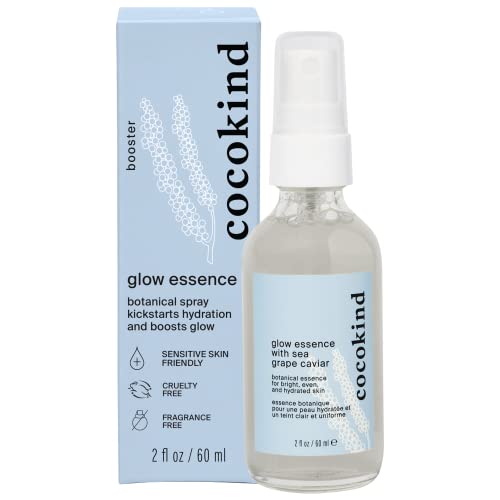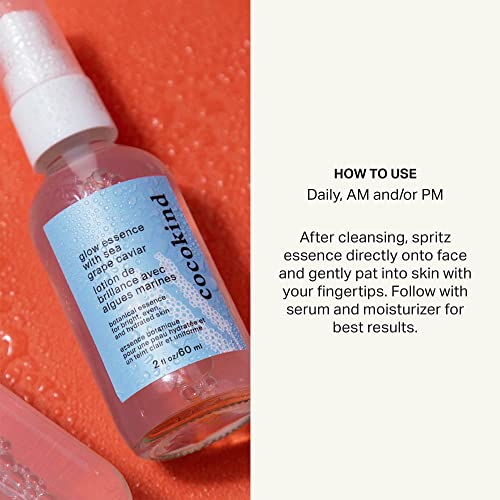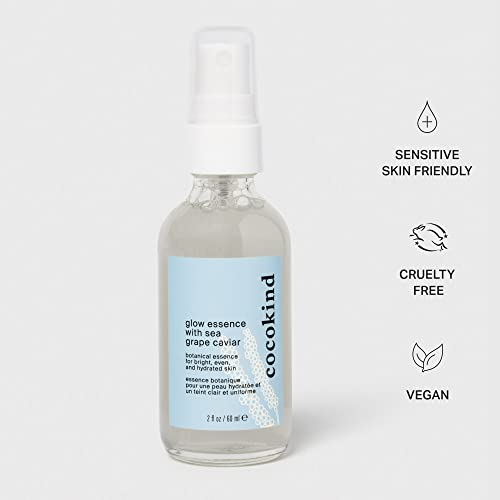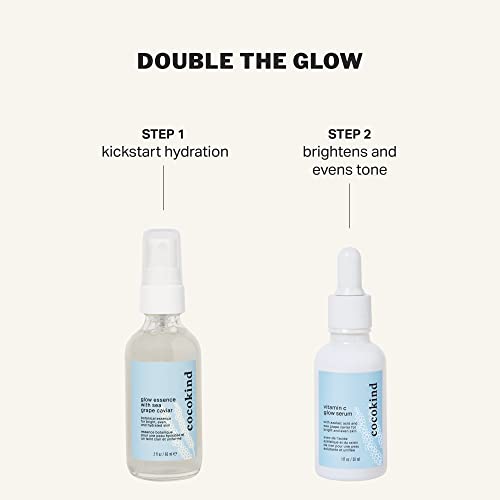





Cocokind Glow Essence Face Mist - Hydrating Primer with Sea Grape Caviar, 4oz


Citrus Aurantium Bergamia (Bergamot) Fruit Oil
High RiskCitrus aurantium bergamia (bergamot) fruit oil is a volatile oil extracted from the fruit of the bergamot orange. It is commonly used in various cosmetic and fragrance products for its aromatic properties.
Sustai Insights
Bergamot oil serves as a fragrant compound with potential benefits in aromatherapy and personal care formulations. However, it is associated with high allergenic potential, with risks of skin irritation and phototoxicity. Regulatory agencies have noted usage restrictions due to these concerns. While the oil is not classified as a carcinogen, it presents moderate risks overall. Caution is advised for sensitive populations, and safer alternatives like sweet orange oil may be considered.
Rosmarinus Officinalis (Rosemary) Leaf Extract
Medium RiskRosemary leaf extract is produced from the leaves of the Rosmarinus officinalis plant. It is commonly used in cosmetic formulations for its potential antioxidant properties and fragrance. The extract may also contribute to the preservation of products due to its antimicrobial characteristics.
Sustai Insights
Rosemary leaf extract offers functional benefits such as antioxidant and antimicrobial properties, which can enhance product stability and shelf-life. It is generally considered low risk for carcinogenicity and reproductive toxicity, but it carries a moderate potential for allergic reactions. Environmentally, it poses low risk with no significant pollutant or bioaccumulation concerns. Regulatory bodies have not placed significant restrictions on its use, although some verified products cannot contain certain concentrations. Overall, the ingredient's risk level is medium, necessitating careful usage practices to mitigate allergic responses.
Eucalyptus Globulus (Eucalyptus) Leaf Oil
Medium RiskEucalyptus globulus leaf oil is a volatile oil derived from the leaves of the eucalyptus tree, primarily used for its aromatic properties and as a potential antimicrobial agent in various products.
Sustai Insights
Eucalyptus globulus leaf oil offers functional benefits like fragrance and potential antimicrobial properties, supporting product efficacy. However, it presents high allergenic potential and moderate irritation concerns, which may pose health risks. Environmental risks include possible pollution and bioaccumulation. Regulatory restrictions are in place regarding its use in certain products. Overall, the risk level is medium, necessitating caution in usage and consideration of alternatives like tea tree oil or peppermint oil.
Algae/Seaweed/Kelp Extract (Species Unspecified)
Medium RiskAlgae extract is an unspecified botanical extract derived from various algae species, commonly used in cosmetic and personal care products for its potential hydrating and nutrient-rich properties. It is valued for its ability to contribute to product formulation by offering texture enhancement and moisture retention.
Sustai Insights
Algae extract offers functional benefits such as hydration and nutrient delivery, which can enhance skin health. Its sustainability credentials may include being biodegradable and derived from renewable sources. However, potential health risks are low, with minimal concerns regarding carcinogenicity, allergens, or reproductive toxicity. Environmental risks primarily involve contamination, while regulatory warnings indicate that it should be sourced responsibly. Overall, the risk level is assessed as medium, suggesting careful usage and consideration of sourcing practices, with alternatives like plant-based extracts available.
Glycerin
Medium RiskGlycerin (also called glycerol) is a naturally occurring compound commonly used in personal care and cosmetic products. It functions as a humectant, attracting moisture to the skin, and is also utilized as a solvent and emollient to enhance product texture and stability.
Sustai Insights
Glycerin is valued for its effective moisturizing properties and biodegradability, making it a widely accepted ingredient in formulations. It poses low health risks, including low concerns for carcinogenicity and allergies. However, moderate use restrictions exist due to regulatory guidelines. While glycerin does not significantly contribute to environmental pollution, its production process should be ethically sourced. Overall, glycerin holds a medium risk level, emphasizing the importance of safe usage practices and considering sustainable alternatives.
Chamomilla Recutita (Matricaria) Water
Low RiskChamomilla recutita (Matricaria) water is derived from the chamomile plant, commonly used in cosmetics for its soothing properties. It functions primarily as a hydrating agent and may also provide calming effects in formulations.
Sustai Insights
Chamomilla recutita (Matricaria) water offers functional benefits such as hydration and skin soothing, with low associated health risks including cancer, allergies, and neurotoxicity. Environmentally, it poses minimal hazards, being biodegradable and not bioaccumulative. Regulatory bodies do not impose significant restrictions on its use. Overall, the ingredient is assessed as low risk, making it a safe choice in cosmetic formulations.
Rosa Canina (Dog Rose) Extract
Low RiskRosa canina (dog rose) extract is derived from the leaves of the Rosa canina plant. It is commonly used in cosmetic formulations for its potential soothing and moisturizing properties. This extract is noted for its presence in various skincare products.
Sustai Insights
Rosa canina extract is valued for its skin-soothing and moisturizing benefits, often found in cosmetics. Scientific evaluations indicate low concerns regarding carcinogenicity, allergenic potential, and irritation, with minimal environmental risks. It is not subject to significant regulatory restrictions, assessing overall risk as low. Safe usage practices include patch testing due to low irritation potential. While alternatives exist, such as other botanical extracts, Rosa canina remains a sustainable choice with a favorable safety profile.
Hippophae Rhamnoides (Sea Buckthorn) Fruit Extract
Low RiskHippophae rhamnoides fruit extract is an extract derived from the sea buckthorn plant, known for its rich content of vitamins, antioxidants, and fatty acids. It is primarily used in cosmetic formulations for its moisturizing, anti-inflammatory, and skin-repairing properties.
Sustai Insights
Hippophae rhamnoides fruit extract offers functional benefits such as moisturizing and anti-inflammatory effects, contributing to skin health. It is sustainably sourced and considered biodegradable. The ingredient presents low health risks, with minimal concerns regarding carcinogenicity and allergies. Environmental impacts are also low, with no significant pollutants or bioaccumulation reported. Regulatory assessments show no restrictions in major markets. Overall, it is deemed a low-risk ingredient, suitable for various applications.
Caulerpa Lentillifera Extract
Low RiskCaulerpa lentillifera extract is derived from a green seaweed known for its potential use in cosmetics and personal care products. It may function as a moisturizing agent and can contribute to the overall texture and stability of formulations.
Sustai Insights
Caulerpa lentillifera extract offers functional benefits such as moisturizing properties and potential antioxidant effects due to its marine origin. It is categorized as low risk concerning health impacts like carcinogenicity, allergenic potential, or reproductive toxicity. Environmental concerns are minimal, with no significant pollutant or bioaccumulation potential reported. Regulatory bodies do not impose restrictions on its use. Usage is generally considered safe, and while alternatives exist, this ingredient maintains a low-risk profile overall.
Sodium Anisate
Low RiskSodium anisate is the sodium salt of p-anisic acid, commonly used as a preservative in various cosmetic and personal care products. It is recognized for its antimicrobial properties, which help to extend the shelf life of products by inhibiting the growth of bacteria and fungi.
Sustai Insights
Sodium anisate serves effectively as a preservative, offering antimicrobial benefits while being biodegradable and potentially sustainably sourced. Health risks are low, with minimal concerns regarding carcinogenicity, allergies, or reproductive toxicity. Environmentally, it poses low risks as it is not bioaccumulative. Regulatory bodies, including the EPA, do not impose significant restrictions on its use. Overall, sodium anisate presents a low risk, making it a favorable choice in formulations, although alternatives should be considered for those seeking greener options.
Sodium Levulinate
Low RiskSodium levulinate is the sodium salt of levulinic acid, primarily used as a preservative and antimicrobial agent in cosmetic and personal care products. It functions effectively in formulations to extend shelf life and prevent microbial growth.
Sustai Insights
Sodium levulinate is recognized for its functional benefits as a preservative with low health risks, including negligible potential for carcinogenicity, allergies, or reproductive toxicity. It is also considered environmentally friendly due to its low pollutant potential and biodegradability. Regulatory bodies have not imposed significant restrictions on its use. Overall, the risk associated with sodium levulinate is assessed as low, making it a suitable choice in various formulations.
Chamomilla Recutita (Matricaria) Water
Low RiskChamomilla recutita (Matricaria) water is derived from the chamomile plant, commonly used in cosmetics for its soothing properties. It functions primarily as a hydrating agent and may also provide calming effects in formulations.
Sustai Insights
Chamomilla recutita (Matricaria) water offers functional benefits such as hydration and skin soothing, with low associated health risks including cancer, allergies, and neurotoxicity. Environmentally, it poses minimal hazards, being biodegradable and not bioaccumulative. Regulatory bodies do not impose significant restrictions on its use. Overall, the ingredient is assessed as low risk, making it a safe choice in cosmetic formulations.
Rosmarinus Officinalis (Rosemary) Leaf Extract
Medium RiskRosemary leaf extract is produced from the leaves of the Rosmarinus officinalis plant. It is commonly used in cosmetic formulations for its potential antioxidant properties and fragrance. The extract may also contribute to the preservation of products due to its antimicrobial characteristics.
Sustai Insights
Rosemary leaf extract offers functional benefits such as antioxidant and antimicrobial properties, which can enhance product stability and shelf-life. It is generally considered low risk for carcinogenicity and reproductive toxicity, but it carries a moderate potential for allergic reactions. Environmentally, it poses low risk with no significant pollutant or bioaccumulation concerns. Regulatory bodies have not placed significant restrictions on its use, although some verified products cannot contain certain concentrations. Overall, the ingredient's risk level is medium, necessitating careful usage practices to mitigate allergic responses.
Rosa Canina (Dog Rose) Extract
Low RiskRosa canina (dog rose) extract is derived from the leaves of the Rosa canina plant. It is commonly used in cosmetic formulations for its potential soothing and moisturizing properties. This extract is noted for its presence in various skincare products.
Sustai Insights
Rosa canina extract is valued for its skin-soothing and moisturizing benefits, often found in cosmetics. Scientific evaluations indicate low concerns regarding carcinogenicity, allergenic potential, and irritation, with minimal environmental risks. It is not subject to significant regulatory restrictions, assessing overall risk as low. Safe usage practices include patch testing due to low irritation potential. While alternatives exist, such as other botanical extracts, Rosa canina remains a sustainable choice with a favorable safety profile.
Eucalyptus Globulus (Eucalyptus) Leaf Oil
Medium RiskEucalyptus globulus leaf oil is a volatile oil derived from the leaves of the eucalyptus tree, primarily used for its aromatic properties and as a potential antimicrobial agent in various products.
Sustai Insights
Eucalyptus globulus leaf oil offers functional benefits like fragrance and potential antimicrobial properties, supporting product efficacy. However, it presents high allergenic potential and moderate irritation concerns, which may pose health risks. Environmental risks include possible pollution and bioaccumulation. Regulatory restrictions are in place regarding its use in certain products. Overall, the risk level is medium, necessitating caution in usage and consideration of alternatives like tea tree oil or peppermint oil.
Hippophae Rhamnoides (Sea Buckthorn) Fruit Extract
Low RiskHippophae rhamnoides fruit extract is an extract derived from the sea buckthorn plant, known for its rich content of vitamins, antioxidants, and fatty acids. It is primarily used in cosmetic formulations for its moisturizing, anti-inflammatory, and skin-repairing properties.
Sustai Insights
Hippophae rhamnoides fruit extract offers functional benefits such as moisturizing and anti-inflammatory effects, contributing to skin health. It is sustainably sourced and considered biodegradable. The ingredient presents low health risks, with minimal concerns regarding carcinogenicity and allergies. Environmental impacts are also low, with no significant pollutants or bioaccumulation reported. Regulatory assessments show no restrictions in major markets. Overall, it is deemed a low-risk ingredient, suitable for various applications.
Caulerpa Lentillifera Extract
Low RiskCaulerpa lentillifera extract is derived from a green seaweed known for its potential use in cosmetics and personal care products. It may function as a moisturizing agent and can contribute to the overall texture and stability of formulations.
Sustai Insights
Caulerpa lentillifera extract offers functional benefits such as moisturizing properties and potential antioxidant effects due to its marine origin. It is categorized as low risk concerning health impacts like carcinogenicity, allergenic potential, or reproductive toxicity. Environmental concerns are minimal, with no significant pollutant or bioaccumulation potential reported. Regulatory bodies do not impose restrictions on its use. Usage is generally considered safe, and while alternatives exist, this ingredient maintains a low-risk profile overall.
Sodium Anisate
Low RiskSodium anisate is the sodium salt of p-anisic acid, commonly used as a preservative in various cosmetic and personal care products. It is recognized for its antimicrobial properties, which help to extend the shelf life of products by inhibiting the growth of bacteria and fungi.
Sustai Insights
Sodium anisate serves effectively as a preservative, offering antimicrobial benefits while being biodegradable and potentially sustainably sourced. Health risks are low, with minimal concerns regarding carcinogenicity, allergies, or reproductive toxicity. Environmentally, it poses low risks as it is not bioaccumulative. Regulatory bodies, including the EPA, do not impose significant restrictions on its use. Overall, sodium anisate presents a low risk, making it a favorable choice in formulations, although alternatives should be considered for those seeking greener options.
Sodium Levulinate
Low RiskSodium levulinate is the sodium salt of levulinic acid, primarily used as a preservative and antimicrobial agent in cosmetic and personal care products. It functions effectively in formulations to extend shelf life and prevent microbial growth.
Sustai Insights
Sodium levulinate is recognized for its functional benefits as a preservative with low health risks, including negligible potential for carcinogenicity, allergies, or reproductive toxicity. It is also considered environmentally friendly due to its low pollutant potential and biodegradability. Regulatory bodies have not imposed significant restrictions on its use. Overall, the risk associated with sodium levulinate is assessed as low, making it a suitable choice in various formulations.
Algae/Seaweed/Kelp Extract (Species Unspecified)
Medium RiskAlgae extract is an unspecified botanical extract derived from various algae species, commonly used in cosmetic and personal care products for its potential hydrating and nutrient-rich properties. It is valued for its ability to contribute to product formulation by offering texture enhancement and moisture retention.
Sustai Insights
Algae extract offers functional benefits such as hydration and nutrient delivery, which can enhance skin health. Its sustainability credentials may include being biodegradable and derived from renewable sources. However, potential health risks are low, with minimal concerns regarding carcinogenicity, allergens, or reproductive toxicity. Environmental risks primarily involve contamination, while regulatory warnings indicate that it should be sourced responsibly. Overall, the risk level is assessed as medium, suggesting careful usage and consideration of sourcing practices, with alternatives like plant-based extracts available.
Citrus Aurantium Bergamia (Bergamot) Fruit Oil
High RiskCitrus aurantium bergamia (bergamot) fruit oil is a volatile oil extracted from the fruit of the bergamot orange. It is commonly used in various cosmetic and fragrance products for its aromatic properties.
Sustai Insights
Bergamot oil serves as a fragrant compound with potential benefits in aromatherapy and personal care formulations. However, it is associated with high allergenic potential, with risks of skin irritation and phototoxicity. Regulatory agencies have noted usage restrictions due to these concerns. While the oil is not classified as a carcinogen, it presents moderate risks overall. Caution is advised for sensitive populations, and safer alternatives like sweet orange oil may be considered.
Glycerin
Medium RiskGlycerin (also called glycerol) is a naturally occurring compound commonly used in personal care and cosmetic products. It functions as a humectant, attracting moisture to the skin, and is also utilized as a solvent and emollient to enhance product texture and stability.
Sustai Insights
Glycerin is valued for its effective moisturizing properties and biodegradability, making it a widely accepted ingredient in formulations. It poses low health risks, including low concerns for carcinogenicity and allergies. However, moderate use restrictions exist due to regulatory guidelines. While glycerin does not significantly contribute to environmental pollution, its production process should be ethically sourced. Overall, glycerin holds a medium risk level, emphasizing the importance of safe usage practices and considering sustainable alternatives.
Discover the Cocokind Glow Essence Hydrating Face Mist, a vegan facial mist designed to enhance hydration, boost your natural glow, and improve product absorption. Infused with nourishing Sea Grape Caviar and Blue Algae Extract, this refreshing mist not only smooths your skin but also retains moisture for a healthy, radiant complexion.
- Hydrating Boost: Enriched with Sea Buckthorn and Linoleic Acid, this face mist revitalizes and softens skin, delivering essential hydration.
- Natural Ingredients: Formulated with plant-based extracts like Chamomile and Eucalyptus, it promotes a soothing skincare experience without harmful chemicals.
- Easy Application: Simply spritz on clean skin post-cleansing for optimal hydration or throughout the day for a refreshing boost.
- Sustainable Choice: Made with recyclable materials, this product aligns with eco-friendly practices, supporting a greener planet.
- Enhanced Absorption: Use as a primer to maximize the effectiveness of subsequent skincare products, ensuring your skin gets the nourishment it deserves.
Subscribe & Save with Sustai
- Best Price Guarantee: Always enjoy the lowest prices on sustainable home essentials.
- No Surprises: We’ll notify you before shipping. No hidden fees, ever.
- You’re in Charge: Change, pause, or cancel your subscription anytime with ease.
- Eco-Friendly Deliveries: Our grouped shipments mean less packaging and lower emissions.
Join us on a sustainable journey. Special offers for a limited time! Prices and promotions may change.
Recommended Products
Discover the Cocokind Glow Essence Hydrating Face Mist, a vegan facial mist designed to enhance hydration, boost your natural glow, and improve product absorption. Infused with nourishing Sea Grape Caviar and Blue Algae Extract, this refreshing mist not only smooths your skin but also retains moisture for a healthy, radiant complexion.
- Hydrating Boost: Enriched with Sea Buckthorn and Linoleic Acid, this face mist revitalizes and softens skin, delivering essential hydration.
- Natural Ingredients: Formulated with plant-based extracts like Chamomile and Eucalyptus, it promotes a soothing skincare experience without harmful chemicals.
- Easy Application: Simply spritz on clean skin post-cleansing for optimal hydration or throughout the day for a refreshing boost.
- Sustainable Choice: Made with recyclable materials, this product aligns with eco-friendly practices, supporting a greener planet.
- Enhanced Absorption: Use as a primer to maximize the effectiveness of subsequent skincare products, ensuring your skin gets the nourishment it deserves.

You can have at most 2 Sustainable Steals products in your cart
Customer Reviews
Customers’ View
Customers appreciate the hydration and quality of the Cocokind Glow Essence, highlighting its effectiveness in keeping skin smooth and evenly hydrated. Many users have reported noticeable improvements in skin texture, with one customer stating, "My skin is noticeably hydrated, soft, and supple." The product's pleasant scent has also received positive feedback, with several reviews mentioning its appealing fragrance. Additionally, customers value the eco-friendly packaging and clean ingredient list, aligning with their environmentally conscious choices. Overall, the Glow Essence is recognized for its ability to enhance skin radiance while supporting a sustainable beauty routine.
AI-generated from the text of customer reviewsThis product is rated 5.0 of 5.0 stars.
It has received 6 reviews.




